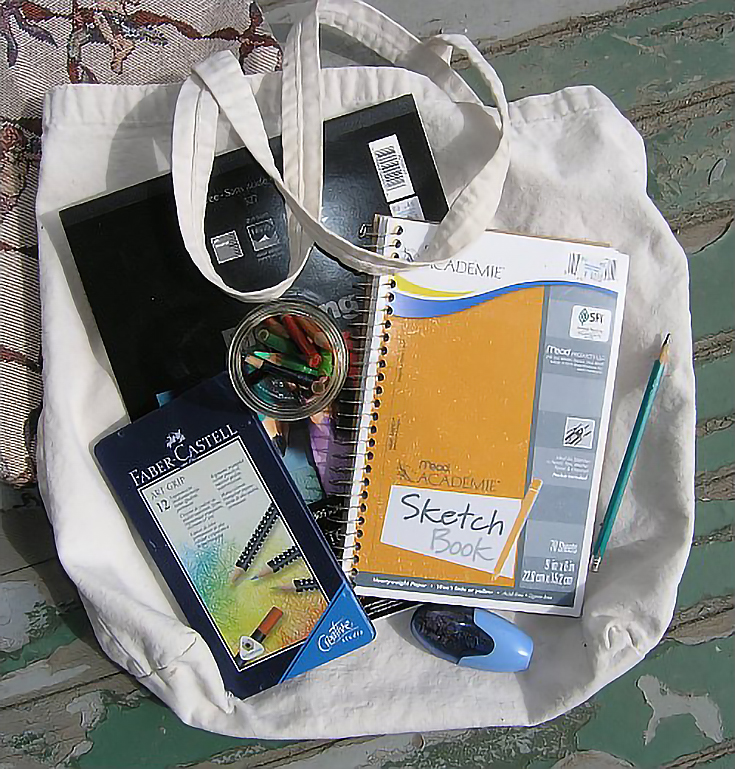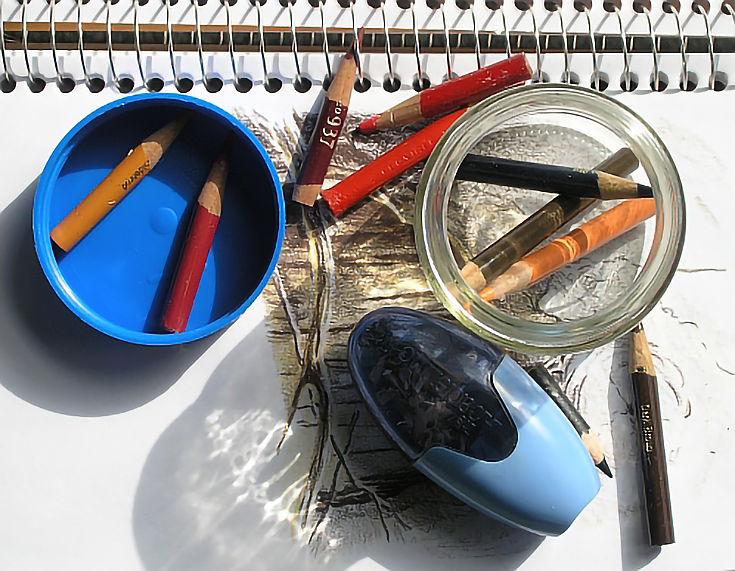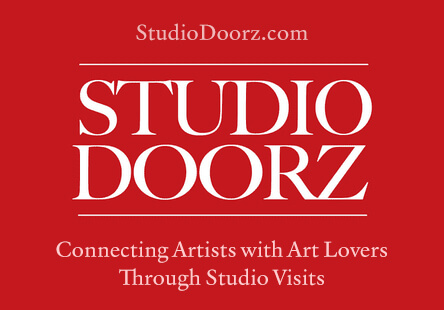With spring returning to the Northern Hemisphere, it’s time to start thinking about getting outside for plein air sketching and drawing. And, while most artists are familiar with plein air work, few of us think of using colored pencils for it—even though they’re the perfect medium for the outdoors.
• They’re lightweight and easy to transport
• They don’t require solvents or water (unless you use water soluble pencils)
• They don’t require drying time
• They come in a wide range of colors so color mixing can be kept to a minimum
If you really want to rough it, all you really need is something to draw with and something to draw on—grab a set of colored pencils and a drawing pad and you’re good to go. But most of us like a few more tools and goodies.
Here’s a photo of what I keep in my travel bag:
As you can see, it’s not a lot, but it does include the following:
1. Field bag
You don’t need anything fancy. The one in the illustration above is a simple canvas bag that’s machine washable and capable of carrying a lot more gear than what I usually carry. You might consider a basic book bag, a laptop carrier (I use a soft-side laptop carrier when I want to take a full set of pencils and more equipment). Or, if you prefer to have your hands free, a backpack is ideal.
2. Small set of pencils
The set shown above is a Faber-Castell Art Grip 12-pencil set. It includes the basic colors and not much else, but it’s good as a starter set or if you want to travel light. Use the brand and number of pencils that best suits your work and what you want to achieve in the field.
3. Small drawing pad
Mine is a 6×9 inch pad, spiral bound so I can fold the pages back. The paper is a heavyweight and lignon-free. It’s suitable for all dry media and even markers.
The bonus to this pad (which is a Mead Academie) is that it has a two-sided pocket page in the front that’s very handy for keeping photos, business cards or loose pages. The size is also ideal for quick sketches or single subject studies, and I do most of my outdoor drawings in this pad.
4. Medium drawing pad
I always take a 9×12 Beinfang Bristol Board, regular surface. I don’t do much field sketching with this, but it’s handy to have along, just in case. It’s acid free and the surface is ideal for detailed studies.
The only drawback with this pad is that it’s tape-bound, instead of spiral bound. The sheets come out of the pad with a smooth edge, which is usually great, but not necessarily for field work. You can work on sheets underneath, but you have to clip them to the cover or you risk having them come out of the pad.
And, if you happen to be working under windy conditions (which is normal in Kansas), you run the risk of losing pages in a wind gust.
5. Graphite pencil
I use Prismacolor’s Turquoise pencils, but any good graphite pencil will work. I prefer a 6B or softer because I can get good dark darks with a minimum of effort. They do smudge very easily, so you might also want to consider something a little harder.
6. Pencil stubs
I keep a small jar with pencil stubs in my field kit. This collection of pencils varies depending on what colors I’ve been using for other drawings. Chances are, they are not colors included in the set of colors listed above, so they are always welcome.
By the way, the jar shown above is a bouillon jar. You know, the kind chicken or beef bouillon cubs come in. It’s the perfect size for all kinds of studio uses.
7. Sharpener
Taking along a sharpener is a must. Ordinarily, I don’t have much use for these inexpensive little sharpeners, but they are handy in the field and safer than carrying a sharpening knife.
The blue one seen in the photo is small enough to fit into the jar with the pencil stubs. It has a compartment to hold pencil shavings, but it’s not very big so you might want a separate container to collect shavings. Something like another bouillon jar, maybe?
8. Erasers
I don’t show an eraser of any kind in my illustrations, but you will want at least one. The ones I carry are a White or Pink Pearl (I prefer White Pearl, but the Pink Pearls are good, too) and a click eraser. A click eraser is a tubular eraser that fits into a pencil-like holder and you use it just like a pencil. They come in a variety of hardnesses and are the perfect tool for erasing or lifting color in small areas.
Other things I didn’t include in this particular kit, that you might want to consider are:
9. Sticky stuff or kneadable eraser
These aren’t generally considered interchangeable, but if you have limited carrying capacity, you can use either one. You can mold each into thin edges or tips to lift color in specific areas or you can toll them between your hands, then roll them over your drawing to create effects like fog or clouds by lifting color.
10. Straight edge
This is another tool that I don’t usually carry but that could come in very handy if you like to draw architectural or man-made things or if you prefer to do more than guesstimate perspective or other features of whatever you’re drawing. Since you’re most likely working small, a six-inch ruler is usually sufficient.
11. Camera
Sometimes you’ll want a more detailed record of the things you draw in the field. Whether you use your smart phone or a regular camera, it never hurts to have the option to take pictures.
And of course, depending on how far from home you’re going and how long you’re planning on being there, you may also want to consider other basic necessities like facial tissues, bottled water, snacks, sun screen, and bug repellent.
Field kits are as individual as the artists who carry them, so experiment with different varieties of tools, equipment, and accessories to find the combination that works best for you. Then get outside, have fun, and make some art!
This post may contain affiliate links.


